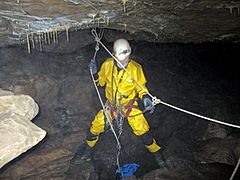Aquamole Pot facts for kids
Quick facts for kids Aquamole Pot |
|
|---|---|

Descending a shaft in Aquamole
|
|
| Location | West Kingsdale, North Yorkshire, UK |
| OS grid | SD 69926 78338 |
| Depth | 113 metres (371 ft) |
| Length | 158 metres (518 ft) |
| Discovery | 1974 |
| Geology | Carboniferous Limestone |
| Entrances | 2 |
| Hazards | Verticality, water |
| Access | Free |
| Cave survey | cavemaps.org |
Aquamole Pot is an exciting limestone cave located in West Kingsdale, North Yorkshire, England. It was first found in 1974 by cave divers. They swam through a long underwater tunnel, called a sump, from another cave called Rowten Pot. This led them to a tall, open space, like a chimney, called an aven.
Most of the early explorations happened from deep inside the cave. Later, a way in was opened from the ground above. Aquamole Pot is part of a huge cave system, about 27 kilometers (17 miles) long. This system helps drain water from both sides of the Kingsdale valley.
Contents
Exploring Aquamole Pot
The Main Entrance and Passages
The main entrance is a deep hole, like a well, about 60 meters (197 feet) deep. It's about 40 meters (44 yards) away from another cave called Jingling Pot. The very top part of this entrance is lined with special blocks.
Below this deep hole, there's a short drop into a small stream passage. After about 50 meters (164 feet), you reach another drop, about 10 meters (33 feet) deep. This leads into a chamber, which is like a room in the cave.
From there, you crawl a bit further. This crawl soon takes you back into the stream passage. After just a few meters, the passage opens up into a large space called Aquamole Aven.
Inside Aquamole Aven
Aquamole Aven is a tall shaft, about 40 meters (131 feet) deep. About 5 meters (16 feet) down, there's a big ledge. At the very bottom of this shaft, if you go downstream (with the water flow), you quickly reach a large pool that is a sump. A sump is an underwater passage that divers explore.
If you go upstream (against the water flow) from the bottom of Aquamole Aven, the passage ends where a small stream flows down from another aven. The downstream sump has been explored for 168 meters (551 feet) and connects to Rowten Pot. The upstream sump is even longer, explored for 920 meters (3,018 feet), and explorers are still finding new parts!
The One-Armed Bandit Series
Above the sump pool, there's a passage that cavers have climbed into. This passage has water flowing from Green Laids Pot. Three tall avens have been climbed in a row, but the way forward eventually becomes too small to fit through.
From the big ledge in Aquamole Aven, a small climb upwards leads to an area called the One-armed Bandit Series. This starts as a wide passage. You have to carefully cross over a deep hole in the floor. Then, the passage splits into two.
To the right, there's a low, wet crawl that ends just before Jingling Pot. To the left, there are several large avens that cavers have climbed almost all the way to the surface.
Another Route to the Sump
The deep holes in the One-Armed Bandit Series offer another way to reach the sump. This route starts with a 24-meter (79-foot) deep shaft. After that, a steeply sloping crack in the rock leads to an 11-meter (36-foot) drop. This drop lands right into the sump pool chamber.
How Aquamole Pot Formed
Aquamole Pot is a karst cave. This means it was formed in limestone rock by water dissolving it over a very long time. The rock it's in is called the Great Scar Limestone Group. This rock was laid down about 335 million years ago, during a time called the Carboniferous Period.
This cave is like a window into the underground water system of West Kingsdale. Water from other caves, like Yordas Cave and Bull Pot, flows through the sump at the bottom of Aquamole Pot. This water eventually comes out at Keld Head, about 1.8 kilometers (1.1 miles) away. It's thought that water from the nearby Jingling Pot used to flow through the One-armed Bandit Series. This water was probably the main source for Aquamole Aven. However, this water has since found new paths and now flows through Jingling Caves.
History of Exploration
The very bottom part of the cave, Aquamole Aven, was first discovered in 1974. Two cave divers, Geoff Yeadon and 'Bear' Statham, found it after diving through the upstream sump at the bottom of Rowten Pot. They started to climb up the aven, which now leads to the One-armed Bandit Series. They stopped after climbing about 9 meters (30 feet).
A team returned in 1980. They used special bolting equipment to finish the climb up the aven. Then, they climbed up a crack at the top to reach the bottom of the 24-meter (79-foot) aven. Large teams helped carry long scaling poles through the sumps. Climbing this aven took two separate trips. They also explored the passage towards Jingling Pot and climbed a series of avens that almost reached the surface. Using radio signals, they found that the upstream junction in the One-armed Bandit Series was about 55 meters (180 feet) from Jingling Pot.
Work started again in 2000. Cave diver Rupe Skorupka wanted to find an easier way to access the upstream sump. He and Martin Holroyd climbed Aquamole Aven to a height of 50 meters (164 feet). The passage became too tight, but they found a second set of passages where water flows in. The top of these passages was found to be about 10 meters (33 feet) below the surface using radio signals. This final connection to the surface was made in June 2002.

